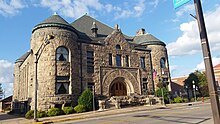Menomonie, Wisconsin History/Dbaumann8
Andrew Tainter (July 6 1823 - October 18, 1899) was a powerful man, he was a leader, a revolutionary, a business man, a father, and a husband. He came to Menomonie in 1845 at the age of 22. After two years of living in Menomonie, Tainter began work for the Knapp and Wilson firm. He married a women who was part of the Ojibwa tribe. This tribe was well populated in the town of Menomonie. Tainter and his first wife had five children together. They were divorced after nine years. In 1859 he hired a lady to teach his children and eventually they got married. They also had five children. The Tainter family built the Mabel Tainter Theater for Arts. This building brings revenue to the town of Menomonie.

Andrews first years in Menomonie
[edit | edit source]At the time of Andrew’s arrival in Menomonie it was mostly inhabited by
an Indian tribe called the Ojibwa. This tribe thrived in the area and survived off of the land that they owned. In 1847 Tainter began to work for the Knapp and CO firm. His work caused him to log within a 20 mile radius of Menomonie. The Knapp And Wilson Company was a large and powerful logging company. A writer for the Wisconsin Historical Society Collections said "It was the greatest lumbar corporation in the world: that in 1873 on the Red Cedar and Chippewa rivers owned 115,000 acres of pine land, and had in its employ, over 1,200 men". In 1850 The company owed Tainter a large amount of money. Their solution to this problem was to simply make him a shareholder of the company.

Captain Tainter
[edit | edit source]Tainter found a wife. This wife was the niece of the local chieftain of the Ojibwa. Her name was Mary Poskin Goose. He built a house in Menomonie and moved in with her. His marriage with Mary lasted 9 years. In that time they had 5 children. They ended up getting divorced. This divorce happened for many reasons. These reasons include cultural differences as well as different ideas for how children should be raised.
Good Work Ethic Counts
[edit | edit source]
Tainter loved working for the Knapp, Stout & Co. He did a lot of very tough jobs for the company. He did these things not because he was good at them, but because he loved he work. Because he loved his work so much he had a passion for it which allowed him to work well and efficiently. Tainter was a man blessed with may leadership capabilities. He possessed the ability to get men to work with him and for him. They worked, not grudgingly, but with a good spirit. This good spirit came from Tainter himself. For in his essence and his heart, Captain Andrew Tainter was a good man.
The Mabel Tainter
[edit | edit source]The Mabel Tainter is the largest testimony to the hard work and dedication of Andrew Tainter. This beautiful building has much mystery and mystique within its thick walls. At its foundation however, the Mabel Tainter was commissioned by Andrew Tainter in order to honor his deceased daughter, Mabel. The cause of Mabel’s’ death is unknown. Rumors fly around and people speculate. The most “interesting” of these rumors is that Mabel died from something known as “cancer of the side”. The cancer of the side is an old fashioned term for a poorly performed abortion. This is by no means confirmed by any official documents. She did, however, die of mysterious causes at a young age. The theater was lavishly decorated. The Board of Directors of the Mabel Tainter said, "The interior of the building contains hand stenciled walls and ceilings, marble staircase and floors, leaded stained glass windows, walnut and oak woodwork, brass fixtures, and four fireplaces, each built with a different stone or technique. The theater still contains the original Steere & Turner tracker pipe organ. The organ has a total of 1597 pipes and 28 stops. The pipes range from 2 inches to 16 feet. Although originally water powered, it was later converted to electric. The organ's restoration began in 1957 and, since then, has been fully restored".
References
[edit | edit source]Hirsch, T. (1976). Our Story, Vol II - Tainter - a legendary figure. Retrieved November 5, 2015.
Liedl, T. (2014, August 22). Descendant of Tainter family visits Menomonie : Dunn County News. Retrieved November 5, 2015.
Historic Mabel Tainter Center for the Arts – One of “15 Spectacular Theaters in the World” (CNN TRAVEL). (n.d.). Retrieved November 5, 2015.
Mabel Tainter Memorial Building. (n.d.). Retrieved November 5, 2015.
Susan, Fanning. "Tainter - A Legendary Figure." Usgennet.org. American Local History Network, Thur Apr. 2000. Web. 12 Dec. 2015.
